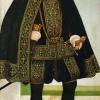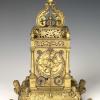Rolling Ball Clock, Augsburg, c. 1600
This monumental clock, which was commissioned by Elector Christian II of Saxony (r. 1591-1611) as a gift to his wife, incorporates a system of automated features into a tower of horological and imperial representation. The clock is regulated by the minute-long descent of a rolling crystal ball, which makes sixteen circuits around the tower while a second ball is lifted to the top of the tower. This eye-catching mechanical display, which requires a perfectly round ball and equally well calibrated spiralling track, has been elongated vertically in order to fuse horological function with an extended surface for symbolic display.
The clock’s structure is reminiscent of the Tower of Babel, which is most often depicted as either a stepped or spiralling conical structure, and as such inserts a geometrical theme into a mechanical device that is internally driven by perfect metal forms. As a piece of mythical architecture and image of lost knowledge, the tower also suggests the passage of time, which is reflected by the procession of silver busts of emperors ranging from the ancient to the contemporary Holy Roman Emperor, Rudolph II (r. 1576-1612). Rudolph II was another powerful patron of Schlottheim and a friend of the Electors of Saxony since August (r. 1553-1586), including Christian II, who is also depicted, memorializing an alliance in time and technology. A descent from antiquity is implied, a claim typical of noble families in the medieval and early modern periods, as it was for creations in which disciplines of knowledge were applied. The ennoblement of knowledge is made explicit with the inclusion of personifications of the seven liberal arts, which stand in niches at the base of the clock. That the liberal arts are imposed upon an object of mechanical ingenuity and labour-intensive handwork signifies the conception of craft as the application one or more of the ancient disciplines. Such a philosophy had been strongly supported by previous Saxon Electors, August in particular, but here the tension between craft and intellect is made part of the clock’s iconographic purpose.
The horological applications of this 112cm tall clock is limited to hours, minutes and a perpetual calendar (on the floor of the balcony), which would have been relatively inaccurate, given the complexity of its novel escapement, and is doubtless a pretext for the mechanically animated ennoblement of sovereignty. More important are the automated horn blowers that herald the passing of the hours almost as their human inspiration would for courtly gatherings. These figures spatially as well as metaphysically support a group of gods dressed as contemporary princes, including Saturn who strikes a bell upon the successful transit of a rolling ball.
At the most basic level, the iconographic system of the clock works at a vertical axis, in which the liberal arts support the emperors of history, who are celebrated by horn blowers, and who are inferior only to deities. That the clock is surmounted by an imperial double eagle and rests upon divisions of ancient learning contributes to what is in effect a sandwich of the ancient and modern, the temporal and the supernatural, the mechanical arts and the liberal. These elements are members of a towering hierarchy, but nonetheless, rely upon one another in the infinite passage of time represented by the continually rolling ball.
Comparison with an Earlier Monumental Clock:
Schlottheim’s clock, a magnificent iconographic and technical statement, can be contrasted with a monumental clock commissioned by Christian II’s grandfather, Elector August (fig. 2). After five years of production, his classically ordered clock was capable of displaying astronomical information that could be used in the devising of horoscopes and the prediction of calendar events- activities vital to rulership (Syndram, 282, 283). Both Christian II’s and August’s monumental clocks are objects of mechanical splendour and statements of knowledge but differ as modes of princely representation and activity, which is clear in their diverging applications of mechanics. One is an eloquent and novel proclamation of power’s multifarity, the other an ordered container of vast, macrocosmic knowledge. The clock in the princely setting, despite its technical function or overt symbolism, was a regulating machine constructed for the regulator of a domain (Syndram, 282, 283).
Commentary: Andrew Biedermann (April, 2022)
Further reading: Dirk Syndram, 'Stately Order', in Dirk Syndram and Antje Scherner, eds., Princely Splendor: The Dresden Court 1580-1620 (Dresden: Staatliche Kunstsammlungen Dresden, 2004).


